
Painting paper wallpapers do it yourself Wallpaper,Walls
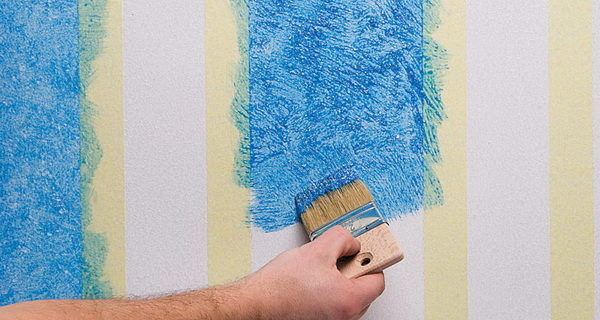
There are several different types of wallpaper for painting, including paper. Paper wallpapers are not the most durable of those that are now offered to choose from. Over time, they fill up, burn out under the influence of sunlight and dumps. Unlike dense, light-resistant and waterproof vinyl or flieslinic wallpapers, paper wallpapers can not wipe with a damp cloth or somehow refresh. In case you have paper wallpapers specially intended for painting or vinyl wallpapers on a paper basis, no problem. They can be simply repainted. However, if you had ordinary paper wallpapers and for some reason you do not want to change these wallpapers, then there is still a way to give them a new life. Any paper wallpaper can also be painted. True, ordinary paper wallpaper is not able to paint several times, since such walls are too thin and not very dense, but at least once it is possible. To do everything right, do it yourself, you need not much at all. About what is needed to do for this and how will it be discussed further.
Content
Materials and tools for work
In order for the work to be performed qualitatively and with the desired result, it is necessary to prepare everything in advance, according to the following list:
- Painting rollers of various widths and structures. Paint the surface with rollers is much faster than tastes. Woolen or mohair are suitable. The foam roller is not desirable, as it can slip on the surface of the wallpaper and leave, after a brilliant track when the paint is dry. Rolls with a pile, before starting painting work, you need to dug in cold water for 1-2 hours, so that the patches become soft and leveled. Before using the roller, it is necessary to squeeze it well and dry.
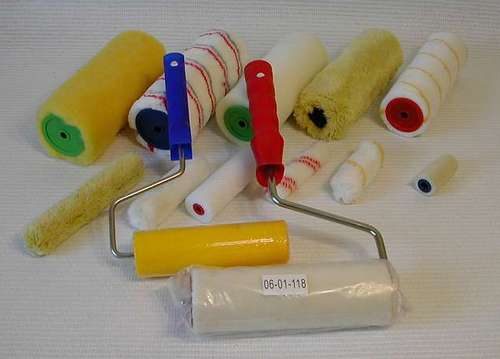
- Paint brushes (wide, medium and narrow). Where the roller is not possible to cope, brushes are used. The length of the hairs of brushes, as well as the length of the pile of rollers, should be selected taking into account the depth of the relief of the decorative wallpaper coverage. The deeper the relief surface of the wallpaper, the longer there should be a pile and hairs of cooked tools.
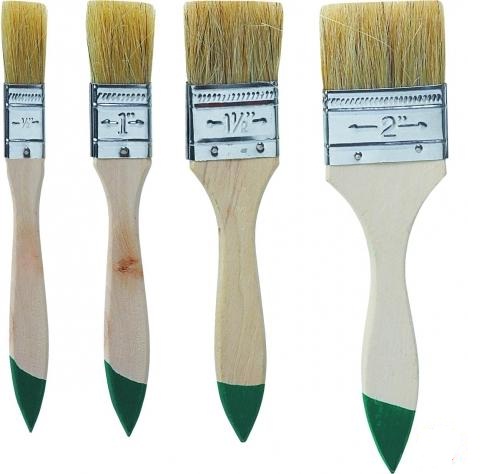
- Vacuum cleaner, brushes, sponge. It will all be needed when preparing the surface of wallpaper to paint.
- Tool for mixing paint. Construction mixer, drill with a special nozzle or can be used just a smooth rail, etc.
- Capacity for mixing paint and paint bath. If there is no painting bath, then it can be replaced with any other suitable for this, capacitance. Place the metal mesh or a piece of the steel plate in this container, you can plywood with holes with holes in it in it (a mesh with a diameter of 12 mm cells and a distance between them is 25 mm). After the roller dip in the paint, it is necessary to ride it several times on this grid, to remove excess paint.
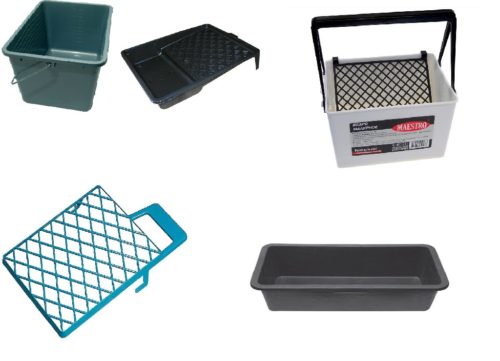
- Malyary Scotch. It will take in order to protect from unintentional staining of plinths, electrical outlets and switches, etc.
- Polyethylene film or dense paper. It will take in order to cover the sections of the floor and other coatings that the paint should be protected from entering them.
- Ladder. For painting wallpapers on the ceiling, if they are there, and in the top of the walls.
- Water-repellent coating. It is necessary to protect the paper structure of wallpaper from scaming, and as a result of this, possible damage and separation from the wall surface.
- Dye.
- If necessary, a paint kel. The kel is needed if you want to give the paint a certain shade of the color gamut. Shades can be chosen independently, but you can pick up in the store with a specialist with a special device.
- Capacity of a small volume (about 100 ml) for the preparation of a test painting composition of paint and a spherical.
Painting Choice for Paper Wallpaper
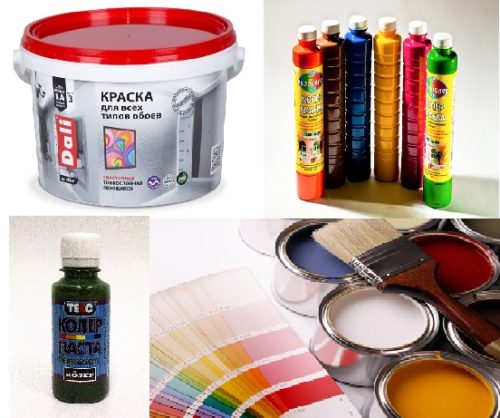
When choosing paint it is necessary to take into account the following:
- Paint can be different in light properties (matte, satin, glossy and mixed properties). It is necessary to choose the paint taking into account the type of surface of wallpaper, illumination and destinations. To do this, it must be remembered that glossy paint will emphasize the available disadvantages of the walls, and they will become more noticeable. Therefore, glossy paint is suitable for indoor rooms with darkened, insecure lighting. Hylder paint - has a good reflective ability. Matte paint - masks surface defects, as it does not have shine and can be used in large rooms. The semi-masted paint - has a slight gloss and blurs the small irregularities of the walls, it fits well into the sleeping area. Satin paint - has a smooth structure, increased wear resistance and durability. It is possible to apply satin paint in any, by appointment and illumination of rooms.
- Does this paint of the painted surface give such properties as moisture resistance (the ability to wash the wallpaper), resistance to artificial lighting or direct sunlight, protected from mechanical influences and other necessary properties.
- The time required for the complete drying of one layer of paint.
- Transparency (crumbling). If the wallpaper is bright (or already painted with bright paint), then you need to know whether this color will cover the new paint completely or through it the previous tint will be shifted.
- What is the basis of paint. There are paints alkyd, aquatic or latex and acrylic. Paint is suitable for paper wallpapers on any basis. Alkid paint creates a protective film on the stained surface. This film gives moisture resistance and resistance to mechanical influences. However, if the surface of the wallpaper is not smooth, but relief, then this film will cover the relief and it will smooth out that it will not allow Wallow to "breathe." The paint on an alkyd basis is not environmentally friendly. Alkyd paints include toxic oils and resins, so it is better to choose such paint for non-residential premises. For residential premises, paints with water-dispersion composition are best suitable (water-resistant paint and its more stable, to various kinds, variation - acrylic). These water-based paints do not smell them quick-drying and eco-friendly. In addition, acrylic paint creates a protective layer on the stained surface, which is well opposed to moisture, direct sunlight, temperature drops and mechanical effects.
Preparation for painting wallpaper
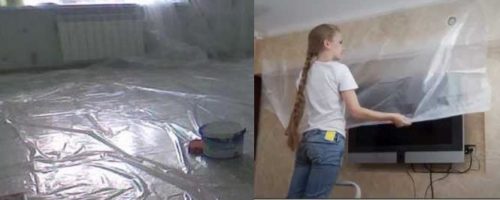
Before painting walls with paper wallpaper, it is necessary to prepare the surfaces and perform other necessary actions:
- Take all items and furniture that will interfere with work. Cover the floor and those covers that should not get paint, plastic film or other prepared, for this, material. Fix the film by paint tape.
- Clamp with paint tape plinth, electrical outlets, switches and other necessary objects, devices and connectors.
- Clean the surface of the wallpaper from dust, web and other contaminants. To do this, use the vacuum cleaner, dry brushes and sponge.
- Close the room all windows and windows, turn off the air conditioners and ventilation. Do not allow drafts and temperature drops. Moistheld wallpapers can be separated from the wall of the wall or under them are formed air bubbles.
- Apply water-repellent coating on the surface of the wallpaper. Use painting rollers and brushes for this. In hard-to-reach places, use narrow painting rollers for angles and joints, as well as painting brushes.
- Dry the wallpaper until complete drying (the drying time should be indicated in the instructions for the use of water-repellent coating). It is better to withstand before painting, after applying a water-repellent composition, not less than 24 hours.
- After the wallpaper is fully prepared for painting, draw up the preparation of the paint. Pour the paint into the prepared container. Stir paint prepared for this tool before receiving a homogeneous mass.
- Perform paint tinting.
Tinting paint
You can perform the paint paint alone. To do this, first mix the kel with paint in the tank of a small volume (about 100 ml) to a homogeneous color. Add a color to a little (literally, drops, you can use a medical syringe) until the desired shade is turned out. Number of drops write down. Apply for sample paint to that section of the wall that you define how suitable for these purposes. Try on the wallpaper area where there is the main, for this room, lighting (artificial or natural). After drying, the paint will evaluate the result. When tipping the main composition of paint, consider that its color on the wall surface will be brighter than in the tank. To calculate the number of the ring, use your records. If you have added 10 drops of a coller for the preparation of a test composition, then for the main coloring composition, it is necessary to reduce this amount by 20%. That is, on 1000 ml paint, not 100 drops of the flaker, but only 80.

Now everything is ready and you can proceed to painting wallpaper.
Painting wallpaper
Wallpaper painting as the final stage must be fulfilled with special responsibility and thoroughness. To achieve the best result, you must adhere to the following advice and the procedures:
- Start painting wallpapers from those sites that will be located for furniture or other elements of the situation. Thus, you will bring your hand and make sure that the selected color shade and successful paint tinting is correct.
- Pre-paint the brushes such places where the paint is impossible for the roller. Using painting brushes, we have a good paint until the desired layer is formed and the shade. After that, proceed to applying paint with roller.
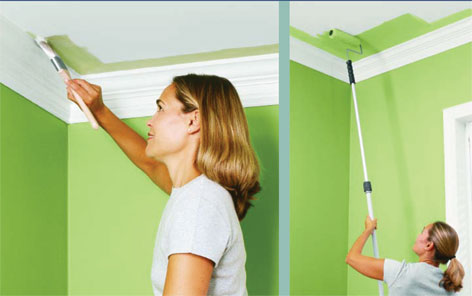
- Wallpaper staining is best done from top to bottom or from the ceiling to the floor. Otherwise, the paint can drain on the already painted surface, thereby spoiling the result. If the wallpaper is present on the ceiling, then the wallpaper is painted there.
- To use the paint application and paint roller tray to a paint colors, trying to make uniform thin layers. Remove excess paint from the roller by rolling, several times, the grid trays, before applying it to the surface of wallpaper.
- Movement of the roller along the wall should be from top to bottom and then from bottom to top.
- paint strokes necessary to impose such a way that each successive stroke overlaps the previous 2-3 cm. On the smooth surface of the paint shade is necessary to more carefully, so as not to remain visible defects.
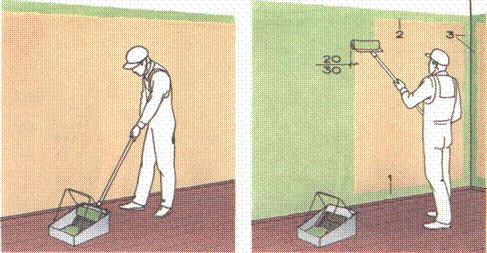
- On the ceiling of the paint must be applied in the direction of light rays. If paint is applied to two layers or more, the layering direction should be perpendicular to each other.
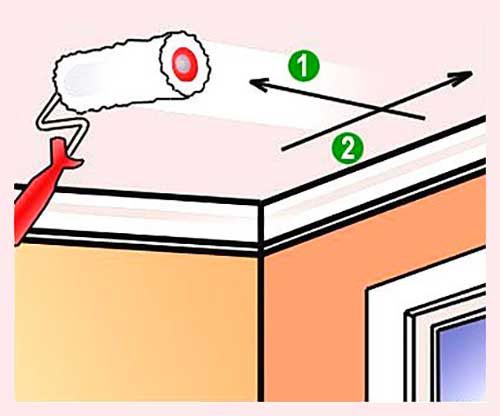
- In remote locations (angles, window and door frames, etc.) for applying the paint prepared using different widths paint brushes and rollers and angles of joints.

- Paint is available in several layers, depending on the desired effect. At a minimum, the paint on paper wallpaper, applied in two coats.
- After application of each paint layer, it must dry at least 4 hours. Then the next layer can be applied.
- Painting can be considered completed after the last coat of paint has dried completely, and you are sure to achieve the desired result. The result should be evaluated under the light, which should be basic.


















